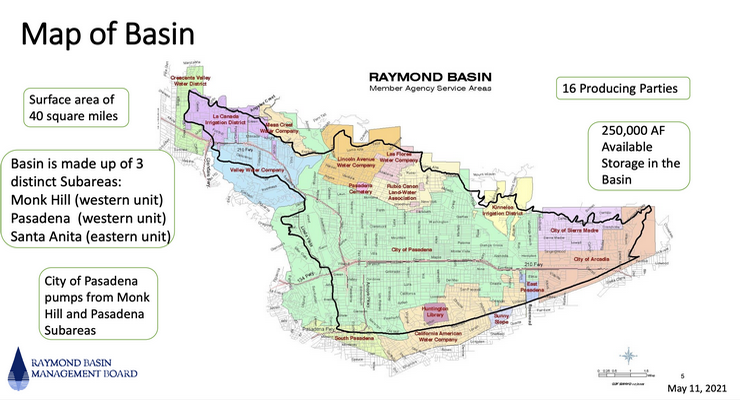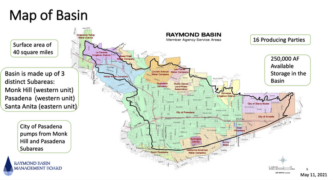
On the heels of Governor Gavin Newsom’s emergency drought declaration expansion on Monday, representatives of the Raymond Basin Management Board will present its 25-year water recovery plan to the City Council Municipal Services Committee Tuesday.
The plan includes, among other elements, pumping groundwater out of lower basins back to the Arroyo Basin north of Hahamongna.
The Raymond Basin is a collection of water-collecting wells and spreading grounds from 16 water-producing entities over a surface area of 40 square miles in a triangle from Crescenta Valley to the west, Arcadia to the east, and down to South Pasadena.
There is 250,000 acre-feet of available water storage in the Basin, according to the report.
The basin is made up of 3 distinct subareas:
-
Monk Hill (western unit)
-
Pasadena (western unit)
-
Santa Anita (eastern unit)
The city of Pasadena pumps from the Monk Hill and Pasadena Subareas.
According to the Raymond Basin presentation, the proposed recovery plan would work to determine “new safe yields” from the pumping areas, and re-evaluate spreading credits.
The plan would also eliminate long-term storage, determine more specific annual water losses, bring in imported water for replenishment, and enhance stormwater capture in the Eaton spreading grounds and the Arroyo Seco.
Additional recovery options to consider, according to the presentation, are to reduce pumping rights, and bring in imported water for direct injection or recharge.
A Metropolitan Water District Regional recycled water program could also shift the source of supply, according to the presentation. Another option would be to shift more production to the Main Basin.
But one local water activist is proposing that the Basin instead simply allow nature to do its job.
“I think they’d been ignoring the long-term drawdown of the basin in a dangerous way,” said Tim Brick, managing director of the Arroyo Seco Foundation. “The basin is really in peril. We’re in danger of losing the Raymond Basin as a water source for the future. It might not happen in the next year or the next five years, but if they continue to operate the way they’ve been operating it won’t be a valuable water resource in the future.”
According to Brick, the Basin Board established a safe yield program in 1944.
“That program or adjudication of water rights was set up in order to stabilize the basin and to make sure that the groundwater level stayed relatively at the same level. But since then, continued Brick, “they haven’t been looking back on how their program actually was affecting the groundwater basin. And so the groundwater level has fallen 250 feet below where it was 80 years ago. That’s just a very dangerous situation.”
Brick contends that the 25-year plan in the Arroyo Seco Canyon project would “aggravate” that situation.
Added Brick, “They want to focus on emphasizing using more local water and pumping more water out of the groundwater basin, but that’s a disastrous strategy long-term.”
Brick contends that Basin management “will take water, and put it into the groundwater basin, and then they’re going to pump it out six months from now, or a year, or two years from now.
“You need to have a sustainable approach,” said Brick. “You need to match what you’re taking out of the ground with what is naturally replenished every year through rainfall and surface runoff.”
Brick claims that spreading basins, which have been used for decades, “aren’t the best mechanism. They’re not as good as the stream itself is for putting water into the groundwater basin. If your goal is putting water into the groundwater basin and keeping it there, the stream does a better job of that.”
The Municipal Services Committee meeting for May 11, 2021, at 4 p.m. is accessible here or at www.pasadenamedia.org.














 0 comments
0 comments


